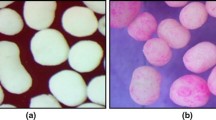Abstract
Beads containing 50% acetaminophen (APAP) and 50% microcrystalline cellulose (Avicel PH 101) were prepared and then coated using an aqueous ethylcellulose based dispersion (Aquacoat) to evaluate the effect of the coating level on drug release. The APAP release was shown to be dependent on levels of the coating and a change in mechanism was suggested. Drug release from incompletely coated beads at low levels of coating can be described with the square root of time model, while drug release from beads with a high level of coating appears to be best described by zero-order release. At low coating levels, the drug release rate constant based on the square root relationship seems to be linear with the coating level. At high coating levels, drug release rate in terms of a zero-order model appears to be proportional to the reciprocal of the coating level.
Similar content being viewed by others
REFERENCES
J. B. Schwartz, A. P. Simonelli, and W. I. Higuchi. Drug release from wax materials. I. Analysis of data with first-order kinetics and with the diffusion-controlled model. J. Pharm. Sci. 57:274–277 (1968).
J. B. Schwartz, A. P. Simonelli, and W. I. Higuchi, Drug release from wax materials. II. Application of a mixture theory to the sulfanilamide-wax system. J. Pharm. Sci. 57:274–277 (1968).
T. Higuchi. Rate of release of medicaments from ointment bases containing drugs in suspension. J. Pharm. Sci. 50:874–875 (1961).
G. H. Zhang, H. Y. Li, and G. J. Liu. Development of controlled release chlorpheniramine pellets. J. China Pharm. Univ. 16:27–30 (1985).
G. L. Flynn, S. H. Yalkowsky, and T. J. Roseman. Mass transport phenomena and models: Theoretical concepts. J. Pharm. Sci. 63:479–510 (1974).
R. W. Baker and H. K. Lonsdale. In C. A. Tanquary and R. E. Lacey (eds.), Controlled Release of Biologically Active Agents, Plenum Press, New York, 1974, Chap. 2.
T. Higuchi. Mechanisms of sustained-action medicine: Theoretical analysis of rate of release of solid drugs dispersed in solid matrices. J. Pharm. Sci. 50:874–875 (1961).
P. I. Lee. Diffusional release of a solute from a polymeric matrix—approximate analytical solutions. J. Membr. Sci. 7:255–275 (1980).
T. J. Roseman and W. I. Higuchi. Release of medroxyprogesterone acetate from a silicone polymer. J. Pharm. Sci. 59:353–357 (1970).
W. P. O'Neill. In A. F. Kydonieus (ed.), Controlled Release Technologies: Methods, Theory, and Applications, CRC Press, Boca Raton, FL, 1980, Chap. 4.
J. Crank. The Mathematics of Diffusion, 2nd ed., Clarendon Press, Oxford, 1975, Chap. 4.
J. R. Robinson and V. H. L. Lee. Controlled Drug Delivery: Fundamentals and Applications, Marcel Dekker, New York, 1987, pp. 181–186.
R. E. O'Connor. Ph.D. dissertation, Philadelphia College of Pharmacy and Science, Philadelphia, 1987.
G. H. Zhang. Ph.D. dissertation, Philadelphia College of Pharmacy and Science, Philadelphia, 1989.
Description of Aquacoat Product, FMC Inc., Philadelphia, 1986.
M. Donbrow and M. Friedman. Enhancement of permeability of ethylcellulose films for drug penetration. J. Pharm. Pharmacol. 27:633–646 (1975).
M. Donbrow and Y. Samuelov. Zero order drug delivery from double-layered porous films: Release rate profiles from ethylcellulose/hydroxypropylcellulose and polyethylene glycol mixtures. J. Pharm. Pharmacol. 32:463–470 (1980).
R. C. Rowe. The effect of the molecular weight of ethylcellulose on the drug release properties of mixed films of ethylcellulose and hydroxypropyl methylcellulose. Int. J. Pharm. 29:37–41 (1986).
L. C. Craig and W. Konigsberg. Dialysis studies. III. Modification of pore size and shape in cellophane membrane. J. Phys. Chem. 65:166–172 (1961).
H. Yasuda and J. T. Tsai. J. Appl. Polym. Sci. 18:805–810 (1974).
Author information
Authors and Affiliations
Rights and permissions
About this article
Cite this article
Zhang, G., Schwartz, J.B. & Schnaare, R.L. Bead Coating. I. Change in Release Kinetics (and Mechanism) Due to Coating Levels. Pharm Res 8, 331–335 (1991). https://doi.org/10.1023/A:1015837330463
Issue Date:
DOI: https://doi.org/10.1023/A:1015837330463




